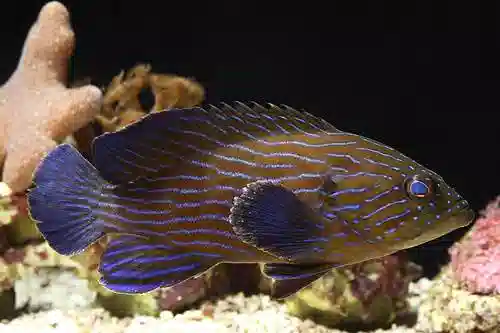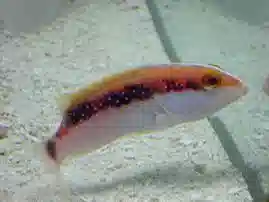Boenacki (Blueline) Grouper
Cephalopholis formosa
(1 Reviews)

Boenacki (Blueline) Grouper
Cephalopholis formosa
(1 Reviews)
{{ item.name }}
Size: {{ item.extra_field_3 }}
${{ getFormattedPrice(item.saleprice) }} ${{ getFormattedPrice(item.price) }}
To join the waiting list, click here
Free Shipping
With
$199.00
or more in Marine Life.
More details...
Boenacki (Blueline) Grouper Care Facts
| Care Level: | Moderate |
|---|---|
| Temperament: | Aggressive |
| Diet: | Carnivore |
| Reef Safe: | No |
| Minimum Tank Size: | 120 gallons |
| Max Size: | 13 inches |
The Boenacki Grouper, Cephalopholis formosa, is a grouper species also known as the Blue-lined Hind or the Bluelined Grouper. They are found in the Indo-Pacific and have a maximum length of 30 centimeters. They have a brownish body with a series of dark bands vertically across its body. They should be kept in larger tanks and will eat most prepared fish foods. They are aggressive and should not be housed with smaller fish.
The Boenacki Grouper (Cephalopholis formosa): A Captivating Addition to Your Saltwater Aquarium
The Boenacki Grouper, scientifically known as Cephalopholis formosa, is a captivating marine species that has become a sought-after addition to saltwater aquariums. This robust and visually striking fish offers enthusiasts a unique experience in marine aquarium keeping. Here, we will delve into essential aspects of caring for the Boenacki Grouper, covering habitat, reef compatibility, size, lifespan, diet, aquaculture availability, tank requirements, water conditions, and more.
Habitat: Originating from the Indo-Pacific
Originating from the Indo-Pacific region, the Boenacki Grouper is commonly found in coral reefs, rocky areas, and sandy bottoms. Its natural habitat is characterized by caves and crevices, providing the fish with shelter and hiding spots. Understanding and replicating these conditions in captivity is crucial for the species' well-being.
Reef Compatibility: Caution for Reef Tank Enthusiasts
The Boenacki Grouper is not considered reef-safe. Due to its predatory nature, it may threaten smaller fish and invertebrates typically found in reef environments. Hobbyists with reef tanks should exercise caution when considering this species for their aquarium.
Size and Lifespan: Growth and Longevity
This grouper species can grow substantially, reaching up to 12 inches long. With proper care, they can live for an extended period, often reaching a lifespan of 10 years or more in captivity.
Diet in Captivity: Carnivorous Preferences
The Boenacki Grouper is carnivorous, and its diet should primarily consist of high-quality marine-based foods. Suitable options include a variety of frozen or live meaty foods such as shrimp, squid, and small fish. Ensuring a well-rounded diet is essential for their health and vibrant coloration.
Aquaculture Availability: Limited Availability
The Boenacki Grouper is not widely aquacultured for the aquarium trade. However, their availability may vary, and it is recommended to check with reputable suppliers for the most up-to-date information.
Compatibility with Other Fish and Invertebrates: Species-Specific Considerations
This grouper species is best kept in a species-specific tank or with larger, more robust tankmates. If they are aggressive towards smaller fish, it is crucial to avoid pairing them with timid or smaller species that may become targets of aggression.
Sexual Dimorphism: Visual Identification Challenges
Sexual dimorphism in the Boenacki Grouper is not readily apparent, making it challenging to distinguish between males and females visually. Hobbyists may need to rely on other cues or consult with experts for accurate identification.
Juvenile to Adult Coloration Changes: Aesthetic Transformations
Juvenile Boenacki Groupers typically display a vibrant blue coloration with distinct markings. As they mature, their coloration may intensify, and the markings become more pronounced, creating a stunning visual impact in the aquarium.
Temperament: Assertive and Territorial Nature
The Boenacki Grouper is known for its assertive and territorial nature. While not overly aggressive, it may display dominance towards smaller or similarly-sized tankmates. Monitoring interactions and providing adequate hiding places to minimize stress is essential.
Tank Requirements: Optimal Conditions for Well-Being
For optimal health and well-being, a minimum aquarium size of 125 gallons is recommended for the Boenacki Grouper. The tank should have caves, rock formations, and ample open swimming space to accommodate their territorial instincts.
Water Conditions: Maintaining Specific Parameters
- pH: 8.1 - 8.4
- Salinity: 1.020 - 1.025
- Water Temperature: 74°F - 78°F
- Water Flow: Moderate to high, replicating the natural currents in their native habitat.
Other Common Names: Variations in Nomenclature
Various common names, including the Blueline Grouper and Blue-Spotted Grouper, also known as the Boenacki Grouper.
Five Compatible Tank Mates: Peaceful Coexistence
- Emperor Angelfish (Pomacanthus imperator)
- Naso Tang (Naso lituratus)
- Foxface Rabbitfish (Siganus vulpinus)
- Coral Beauty Angelfish (Centropyge bispinosa)
- Harlequin Tuskfish (Choerodon fasciatus)
Why Choose the Boenacki (Blueline) Grouper from Saltwaterfish.com: A Trusted Source
Saltwaterfish.com stands out as a reputable source for acquiring the Boenacki Grouper for several reasons. They prioritize the health and well-being of their aquatic specimens, offering tank-raised and carefully acclimated fish. With a commitment to sustainable practices, Saltwaterfish.com provides hobbyists with ethically sourced marine life, ensuring a positive and responsible aquarium experience.
In conclusion, the Boenacki Grouper is a captivating addition to saltwater aquariums, bringing beauty and personality to the underwater landscape. Understanding their specific requirements and compatibility considerations and sourcing from reputable suppliers like Saltwaterfish.com ensures a successful and rewarding experience for marine enthusiasts.
The Boenacki (Blueline) Grouper are great fish. They acclimated very well. They are always out and swimming around. Their color changes under my lighting. Fun to watch.
Reviewed by: Max Didia on Sept. 12, 2021















